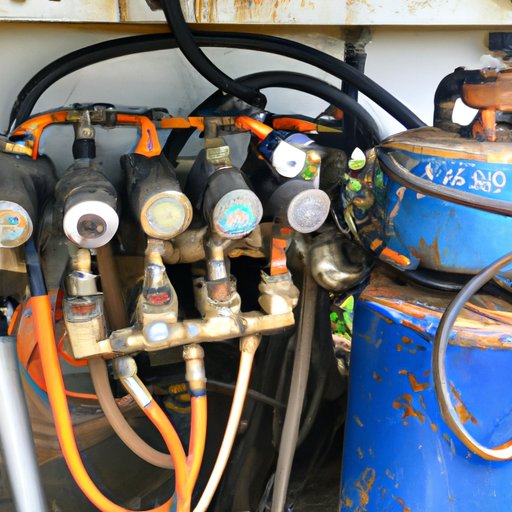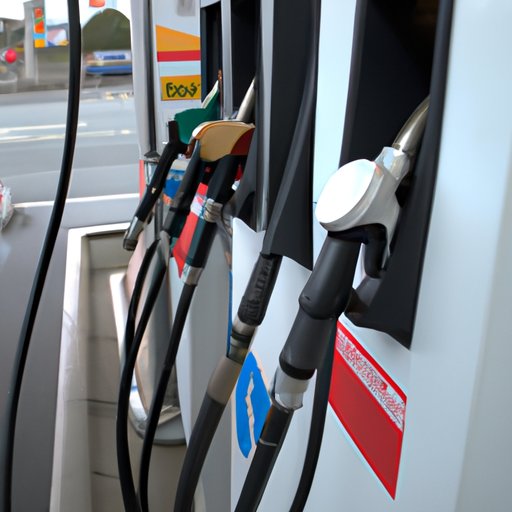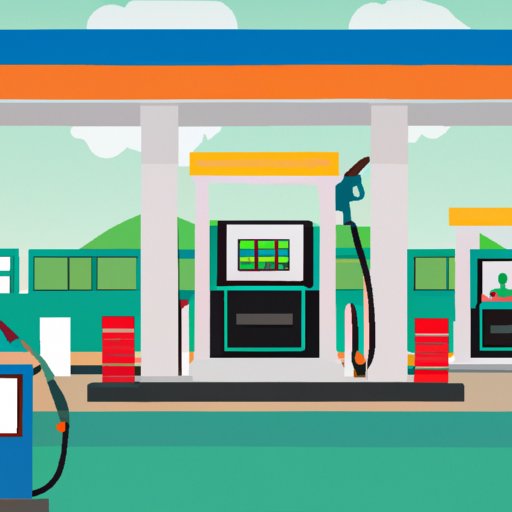Introduction
Gas stations are an essential part of modern life. Whether you’re running errands or taking a road trip, chances are you’ll need to stop at a gas station along the way. But have you ever stopped to think about how gas stations actually work? This article will explore the mechanics of a gas station and what you need to know about operating one.

Exploring the Mechanics of a Gas Station: How it Works
When you pull up to a gas station, there are several steps that must occur in order for you to refuel your vehicle. First, you need to select the type of fuel you want. Most gas stations offer regular, mid-grade, and premium grade gasoline, as well as diesel and alternative fuels like E85 ethanol. Once you’ve selected the type of fuel you want, you can proceed to a pump where you can insert your credit card or pay cash. After payment has been processed, you can choose the amount of fuel you want to purchase, and then begin fueling your vehicle.
The basic structure of a gas station consists of the pumps, tanks, and other equipment needed to store and dispense fuel. The pumps are connected to underground tanks via a system of pipes and valves. These tanks are typically made of steel and are designed to contain multiple grades of fuel. The tanks are also equipped with sensors that measure the level of fuel in the tank so that the station always knows when to order more fuel.

Gas Station Operations 101: What You Need to Know
When considering the cost of operating a gas station, there are a few key factors to take into account. First, the cost of fuel itself is the biggest expense for any gas station. In addition to fuel costs, you must also factor in labor costs, rent, utilities, maintenance costs, taxes, insurance, and other overhead costs. All of these costs can quickly add up, so it’s important to understand the financial implications of running a gas station before taking on the task.
In addition to costs, there are also certain regulations and guidelines that must be followed when operating a gas station. For example, most states require that all gas stations comply with safety standards such as proper storage and labeling of fuel, installation of fire suppression systems, and use of appropriate signage. It’s important to familiarize yourself with the laws and regulations in your state before opening a gas station.
Safety measures are also essential for any gas station. To ensure the safety of customers and employees, it’s important to have proper lighting, security cameras, and clearly marked exits. Additionally, all employees should be trained in the proper handling of hazardous materials and the use of personal protective equipment (PPE).
The Ins and Outs of Running a Gas Station
Staffing requirements for a gas station vary depending on the size and scope of the operation. Generally speaking, you will need at least one full-time employee to manage the day-to-day operations of the station. Depending on the hours of operation, you may also need additional staff to cover shifts.
In addition to staffing, there are certain pieces of equipment that are necessary for a gas station to operate. At a minimum, you will need fuel pumps, tanks, and dispensers, as well as hoses and nozzles for refueling vehicles. You will also need specialized equipment such as a cash register, credit card reader, and point-of-sale system.
Finally, regular maintenance is essential for any gas station. This includes routine inspections of tanks and pumps, as well as cleaning and replacing filters and hoses. It’s also important to keep the station clean and organized, as this will help create a positive experience for customers.
A Step-by-Step Guide to Understanding How Gas Stations Operate
Now that you have a better understanding of the basics of operating a gas station, let’s take a look at the process involved in refueling a vehicle. When you arrive at a gas station, you will first need to select the type of fuel you want to purchase. Once you’ve done this, you can proceed to a pump where you can insert your credit card or pay cash.
After payment has been processed, you can then choose the amount of fuel you want to purchase. You can do this by either selecting a specific dollar amount or a specific quantity of fuel. Once you’ve made your selection, you can begin refueling your vehicle.
At the end of the transaction, you will need to complete the payment process. This typically involves signing a receipt or entering a PIN number. Once the transaction is complete, you can drive away with a full tank of gas!
Behind the Scenes: What Happens at a Gas Station?
While refueling your vehicle is the most visible aspect of a gas station, there is much more that goes on behind the scenes. Managing inventory is an important part of operating a gas station, as you must ensure that you always have enough fuel in stock to meet customer needs. You will also need to monitor fuel prices to ensure that you are competitive with other stations in the area.
Security protocols are also essential for any gas station. This includes installing surveillance cameras and other security measures to deter theft and vandalism. Additionally, all employees should be trained in proper safety protocols and handling of hazardous materials.
Finally, environmental considerations are an important factor in operating a gas station. This includes following all applicable laws and regulations regarding the storage and disposal of fuel, as well as taking steps to reduce pollution and conserve resources.

Uncovering the Mystery of How Gas Stations Function
Even after understanding the mechanics of a gas station and what goes on behind the scenes, there are still many unanswered questions about how gas stations function. Common issues that arise include customer complaints, slow sales, and difficulty managing inventory. To address these issues, it’s important to have a clear understanding of the business side of operating a gas station.
Troubleshooting tips for gas station owners include staying up-to-date on industry trends, monitoring competitors, and offering promotions and discounts to attract customers. Additionally, it’s important to have a system in place for tracking sales and inventory to ensure that you always have enough fuel in stock. Finally, best practices for gas station operation include maintaining a clean and organized facility, providing excellent customer service, and staying current on safety regulations.
An In-depth Look into the Business of Operating a Gas Station
Once you have a good understanding of how gas stations operate, it’s time to consider how to make your station profitable. Strategies for increasing profits at a gas station include offering high-quality fuel at competitive prices, providing value-added services such as car washes and convenience stores, and using loyalty programs to reward frequent customers.
Marketing is another important aspect of running a successful gas station. This includes creating a website, advertising on social media, and leveraging local partnerships to reach new customers. Additionally, it’s important to stay engaged with your customers and build relationships with them.
Finally, there are several tips for growing a gas station business. These include investing in technology to streamline operations, exploring new revenue streams such as selling merchandise, and expanding your offerings to include food and beverages. Additionally, it’s important to carefully manage expenses and stay up-to-date on industry trends.
Conclusion
Operating a gas station is no easy feat. From understanding the mechanics of a gas station to uncovering the mystery of how they function, this article has provided a comprehensive look into how gas stations work and operate. We explored topics such as the cost of operating a gas station, regulations and guidelines, maintenance tasks, strategies for increasing profits, and more. With this knowledge, you should now have a better understanding of the ins and outs of running a gas station.
Running a gas station is a complex endeavor, but with the right knowledge and dedication, it can be a rewarding and profitable business. By following the tips outlined in this article, you can be well on your way to success.
(Note: Is this article not meeting your expectations? Do you have knowledge or insights to share? Unlock new opportunities and expand your reach by joining our authors team. Click Registration to join us and share your expertise with our readers.)
